Brazilian Consumers’ Perception towards Food Labeling Models Accompanying Self-Service Foods
Abstract
1. Introduction
2. Materials and Methods
2.1. Survey Subjects
2.2. Survey Procedure
- (1)
- Sociodemographic questions:
- (2)
- Evaluation of sandwich choice and intervening aspects:
- (3)
- Food label—preference, understanding, and perceptions:
2.3. Data Analysis
2.4. Ethics Committee
3. Results
3.1. Subject Profiles (Sociodemographic Questions)
3.2. Sandwich Choice and Intervening Aspects
3.3. Food Label—Preference, Understanding, and Perceptions
3.3.1. Consumers’ Understanding about the Food Labeling Models
3.3.2. General Opinion on Nutrition Labels at Food Services
“I agreed with all labels and believed they could totally influence people to improve their eating habits.”(line 70)
“The commented items will really help when choosing food for consumption.”(line 250)
“We are more aware of food labels. I think it is important to clarify.”(line 204)
“Too much sodium”(line 310)
“Without any warning”(line 70)
“Does not have a warning”(line 70)
“Does not have warnings”(line 386)
“Has the information that it does not have any warning”(line 288)
“Worry about the washing of greens and vegetables”(line 377)
“For not eating green salad away from home, due to uncertainty about how it was washed (or if it was washed)”(line 231)
“I am afraid of eating uncooked salad where I am not sure it was properly washed”(line 279)
4. Discussion
4.1. Subject Profiles
4.2. Sandwich Choice and Intervening Aspects
4.3. Food Label—Preference, Understanding, and Perceptions
“It would be good if all foods had a traffic-light label, which would call more attention for the people to consume”(line 97)
“I liked the traffic-light label because even if the consumer does not fully understand the ingredients, at least he/she will have the color signals. I think the model with a magnifying glass is good, though inefficient because if the consumer does not understand what “saturated fat” is, he/she will not be able to say if it is good or not to have a high level of this in the food. The traditional model is not so good, since it does not indicate the benefits or disadvantages”(line 637)
“The traffic-light model is more pleasant because it shows both sides of the food, not dichotomizing into “unhealthy” and “healthy”(line 177)
“The warnings are important, but I think the traffic-light model is very good, with useful and accessible information”(line 159)
5. Conclusions
Study Limitations
Author Contributions
Funding
Institutional Review Board Statement
Informed Consent Statement
Data Availability Statement
Acknowledgments
Conflicts of Interest
References
- Brasil; Ministério da Saúde; Secretaria de Vigilância em Saúde; Departamento de Análise em Saúde e Vigilância de Doenças não Transmissíveis. Vigitel Brasil 2018: Vigilância de Fatores de Risco e Proteção Para Doenças Crônicas Por Inquerito Telefônico; Ministério da Saúde: Brasília, Brasil, 2019; ISBN 9788533427051.
- International Diabetes Federation. IDF Diabetes Atlas, 8th ed.; International Diabetes Federation: Bruxelas, Belgium, 2017; ISBN 9782930229874. [Google Scholar]
- Brasil; Ministério da Saúde; Secretaria de Vigilância em Saúde; Secretaria de Gestão Estratégica e Participativa. Vigitel Brasil 2006: Vigilância de Fatores de Risco e Proteção Para Doenças Crônicas Por Inquérito Telefônico; Ministério da Saúde: Brasília, Brasil, 2006; ISBN 9788533415652.
- Brasil; Ministério da Saúde; Secretaria de Vigilância em Saúde; Departamento de Vigilância de Doenças e Agravos não Transmissíveis e Promoção da Saúde. Vigitel Brasil 2014: Vigilância de Fatores de Risco e Proteção Para Doenças Crônicas Por Inquérito Telefônico; Ministério da Saúde: Brasília, Brasil, 2015; Volume 22, ISBN 9788533422438.
- Malta, D.C.; Silva, J.B., Jr. da O Plano de Ações Estratégicas Para o Enfrentamento Das Doenças Crônicas Não Transmissíveis No Brasil e a Definição Das Metas Globais Para o Enfrentamento Dessas Doenças Até 2025: Uma Revisão. Epidemiol. Serviços Saúde 2013, 22, 151–164. [Google Scholar] [CrossRef]
- Brasil; Ministério da Saúde; Secretaria de Vigilância em Saúde; Departamento de Análise de Situação de Saúde. Plano de Ações Estratégicas Para o Enfrentamento Das Doenças Crônicas Não Transmissíveis (DCNT) No Brasil 2011–2022; Ministério da Saúde: Brasília, Brazil, 2011.
- Jáuregui, A.; Vargas-Meza, J.; Nieto, C.; Contreras-Manzano, A.; Alejandro, N.Z.; Tolentino-Mayo, L.; Hall, M.G.; Barquera, S. Impact of Front-of-Pack Nutrition Labels on Consumer Purchasing Intentions: A Randomized Experiment in Low- and Middle-Income Mexican Adults. BMC Public Health 2020, 20, 463. [Google Scholar] [CrossRef] [PubMed]
- Plasek, B.; Lakner, Z.; Temesi, Á. Factors That Influence the Perceived Healthiness of Food—Review. Nutrients 2020, 12, 1881. [Google Scholar] [CrossRef] [PubMed]
- Bryla, P. Who Reads Food Labels? Selected Predictors of Consumer Interest in Front-of-Package and Back-of-Package Labels during and after the Purchase. Nutrients 2020, 12, 2605. [Google Scholar] [CrossRef] [PubMed]
- Christoph, M.J.; Loth, K.A.; Eisenberg, M.E.; Haynos, A.F.; Larson, N.; Neumark-Sztainer, D. Nutrition Facts Use in Relation to Eating Behaviors and Healthy and Unhealthy Weight Control Behaviors. J. Nutr. Educ. Behav. 2018, 50, 267–274.e1. [Google Scholar] [CrossRef]
- Brasil. Guia Alimentar Para a População Brasileira, 2nd ed.; Ministério da Saúde, Ed.; Ministério da Saúde: Brasilia, Brazil, 2014; ISBN 978-85-334-2176-9.
- Brasil; Ministério da Saúde; Agência Nacional de Vigilância Sanitária. RDC N° 429, de 8 de Outubro de 2020; Ministério da Saúde: Rio de Janeiro, Brazil; Agência Nacional de Vigilância Sanitária: Brasília, Brazil, 2020; Volume 53, pp. 1689–1699.
- Brasil; Ministério da Saúde; Agência Nacional de Vigilância Sanitária. Instrução Normativa IN No 75, de 8 de Outubro de 2020; Ministério da Saúde: Rio de Janeiro, Brazil; Agência Nacional de Vigilância Sanitária: Brasília, Brazil, 2020; pp. 1–31.
- Brasil; Ministério da Saúde; Agência Nacional de Vigilância Sanitária. RDC N° 26, de 2 de Julho de 2015; Diário Oficial da República Federativa do Brasil: Brasília, Brazil, 2015; Volume 2015.
- Food and Agriculture Organization of the United Nations. Handbook on Food Labelling To Protect Consumers; FAO: Rome, Italy, 2016; ISBN 9789251095478. [Google Scholar]
- Brasil; Agência Nacional de Vigilância Sanitária. Relatório Preliminar de Análise de Impacto Regulatório Sobre Rotulagem Nutricional; Agência Nacional de Vigilância Sanitária: Brasília, Brazil, 2018; p. 249.
- Gorgulho, B.M.; Fisberg, R.M.; Marchioni, D.M.L. Nutritional Quality of Major Meals Consumed Away from Home in Brazil and Its Association with the Overall Diet Quality. Prev. Med. 2013, 57, 98–101. [Google Scholar] [CrossRef] [PubMed]
- Bezerra, I.N.; Cavalcante, J.B.; Moreira, T.M.V.; da Mota, C.C.; Sicheiri, R. Eating Away from Home and Excess Weight: An Analysis of Explanatory Mechanisms. Rev. Bras. Promoç Saúde 2016, 29, 455–461. [Google Scholar]
- Cavalcante, J.B.; Moreira, T.M.V.; da Mota, C.C.; Pontes, C.R.; Bezerra, I.N. Ingestão de Energia e Nutrientes Segundo Consumo de Alimentos Fora Do Lar Na Região Nordeste: Uma Análise Do Inquérito Nacional de Alimentação 2008–2009. Rev. Bras. Epidemiol. 2017, 20, 115–123. [Google Scholar] [CrossRef][Green Version]
- Thomas, E. Commentary Food for Thought: Obstacles to Menu Labelling in Restaurants and Cafeterias. Public Health Nutr. 2015, 19, 2182–2185. [Google Scholar] [CrossRef]
- Vanderlee, L.; Branco, C.; Hammond, H. Evaluation of a Voluntary Nutritional Information Program versus Calorie Labelling on Menus in Canadian Restaurants: A Quasi-Experimental Study Design. Int. J. Behav. Nutr. Phys. Act. 2019, 16, 1–10. [Google Scholar] [CrossRef]
- Block, J.P.; Roberto, C.A. Potential Benefits of Calorie Labeling in Restaurants. HHS Public Access 2014, 887–888. [Google Scholar] [CrossRef] [PubMed]
- Meilgaard, M.; Civille, G.V.; Carr, B.T. Sensory Evaluation Techniques; CRC Press: Boca Raton, FL, USA, 1999; Volume 3, ISBN 0-8493-0276-5. [Google Scholar]
- Dutcosky, S.D. Análise Sensorial de Alimentos; Curitibia: Champagnat, Brazil, 2011; Volume 3, ISBN 978-85-7292-244-9. [Google Scholar]
- Ricci, B.C.; Brasil, V.S.; de Almeida, S.O. Labelling in Self-Service Retail: Can the Presented Form of Nutritional Information on Packaging Increase Perceptions of Healthiness and Purchase Intention? Rev. Bras. Mark. 2020, 19, 427–447. [Google Scholar] [CrossRef]
- Borgmeier, I.; Westenhoefer, J. Impact of Different Food Label Formats on Healthiness Evaluation and Food Choice of Consumers: A Randomized-Controlled Study. BMC Public Health 2009, 9, 1–12. [Google Scholar] [CrossRef]
- Siegrist, M.; Leins-Hess, R.; Keller, C. Which Front-of-Pack Nutrition Label Is the Most Efficient One? The Results of an Eye-Tracker Study. Food Qual. Prefer. 2015, 39, 183–190. [Google Scholar] [CrossRef]
- Brasil. Resolução n. 466, de 12 de Dezembro de 2012. Dispõe Sobre as Diretrizes e Normas Regulamentadoras de Pesquisas Envolvendo Seres Humanos; Ministério da Saúde: Brasilia, Brazil, 2012.
- Svendsen, K.; Torheim, L.E.; Fjelberg, V.; Sorprud, A.; Narverud, I.; Retterstøl, K.; Bogsrud, M.P.; Holven, K.B.; Myhrstad, M.C.W.; Telle-Hansen, V.H. Gender Differences in Nutrition Literacy Levels among University Students and Employees: A Descriptive Study. J. Nutr. Sci. 2021, 10, e56. [Google Scholar] [CrossRef] [PubMed]
- Michou, M.; Panagiotakos, D.B.; Lionis, C.; Costarelli, V. Socioeconomic Inequalities in Relation to Health and Nutrition Literacy in Greece. Int. J. Food Sci. Nutr. 2019, 70, 1007–1013. [Google Scholar] [CrossRef] [PubMed]
- Corey, K.L.; McCurry, M.K.; Sethares, K.A.; Bourbonniere, M.; Hirschman, K.B.; Maghani, S.H. Utilizing Internet-Based Recruitment and Data Collection to Access Different Age Groups of Former Family Caragivers. Appl. Nurs. Res. 2018, 44, 82–87. [Google Scholar] [CrossRef] [PubMed]
- Faleiros, F.; Käppler, C.; Ramos Pontes, F.A.; Souza, S.; Silva, D.C.; Dos, F.; Nogueira De Goes, S.; Cucick, C.D. Uso De Questionário Online E Divulgação Virtual Como Estratégia De Coleta De Dados Em Estudos Científicos Use of Virtual Questionnaire and Dissemination As a Data Collection Strategy in Scientific Studies. Artig. Orig. Texto Contexto Enferm 2016, 25, 3–8. [Google Scholar]
- Ni Mhurchu, C.; Eyles, H.; Jiang, Y.; Blakely, T. Do Nutrition Labels Influence Healthier Food Choices? Analysis of Label Viewing Behaviour and Subsequent Food Purchases in a Labelling Intervention Trial. Appetite 2018, 121, 360–365. [Google Scholar] [CrossRef]
- Lima, M.; Ares, G.; Deliza, R. How Do Front of Pack Nutrition Labels Affect Healthfulness Perception of Foods Targeted at Children? Insights from Brazilian Children and Parents. Food Qual. Prefer. 2018, 64, 111–119. [Google Scholar] [CrossRef]
- Chen, P.-J.; Antonelli, M. Conceptual Models of Food Choice: Influential Factors Related to Foods, Individual Differences, and Society. Foods 2020, 9, 1898. [Google Scholar] [CrossRef] [PubMed]
- Souza, K.R.; Rozemberg, B.; Kelly-Santos, A.; Sharapin, M. O Desenvolvimento Compartilhado de Impressos Como Estratégia de Educação Em Saúde Junto a Trabalhadores de Escolas Da Rede Pública Do Estado Do Rio de Janeiro. Cad. Saúde Pública 2003, 19, 495–504. [Google Scholar] [CrossRef] [PubMed][Green Version]
- De Carvalho, A.T.; Muniz, V.M.; Gomes, J.F.; Samico, I. School Meals Program in the Municipality of João Pessoa, Paraíba, Brazil: School Meal Cooks in Focus. Interface Commun. Health Educ. 2008, 12, 823–834. [Google Scholar] [CrossRef]
- Gabor, A.M.; Stojnić, B.; Ban Ostić, D. Effects of Different Nutrition Labels on Visual Attention and Accuracy of Nutritional Quality Perception—Results of an Experimental Eye-Tracking Study. Food Qual. Prefer. 2020, 84, 103948. [Google Scholar] [CrossRef]
- Tian, Y.; Yoo, J.H.; Zhou, H. To Read or Not to Read: An Extension of the Theory of Planned Behaviour to Food Label Use. Int. J. Consum. Stud. 2021, 1–10. [Google Scholar] [CrossRef]
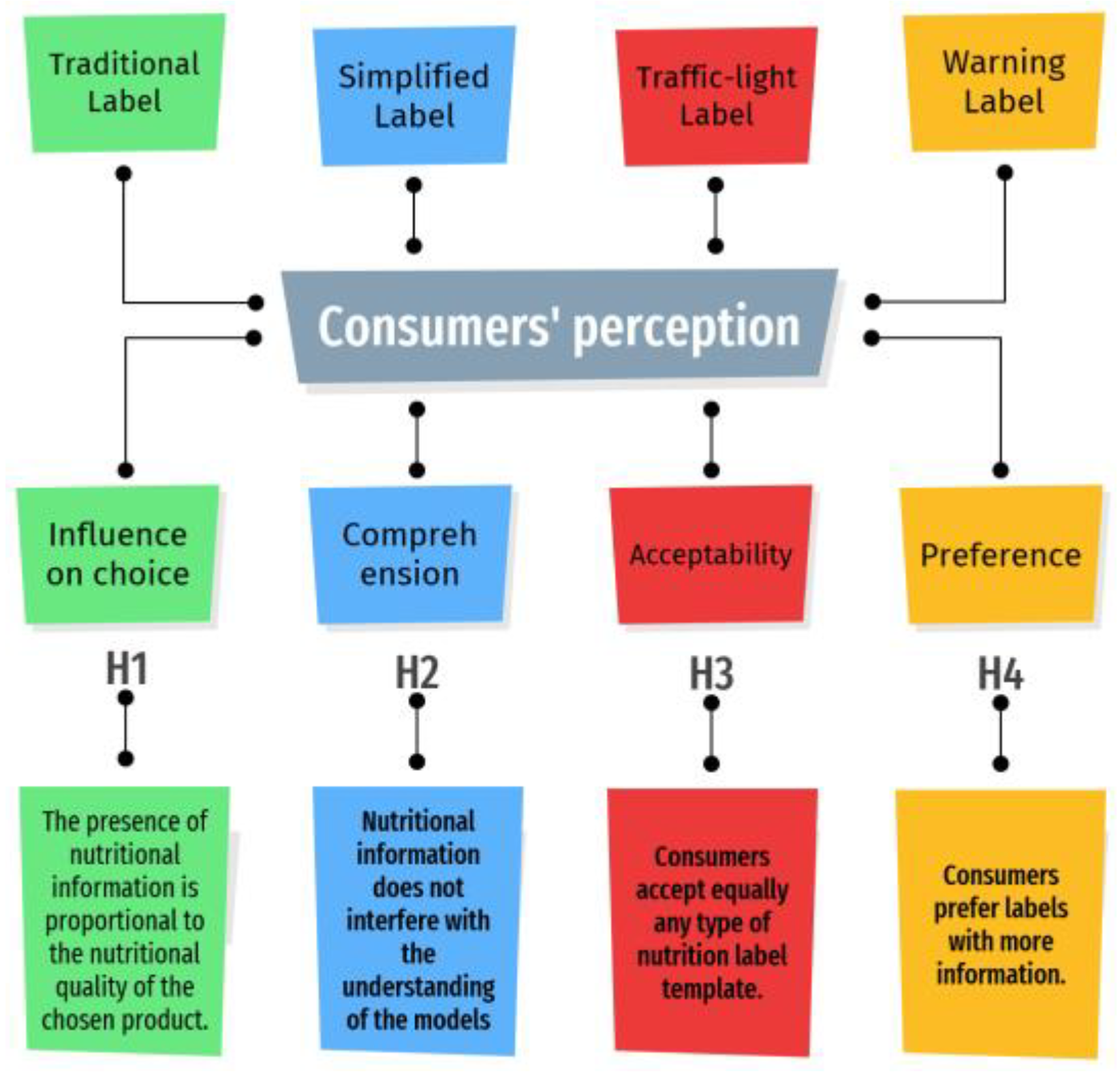

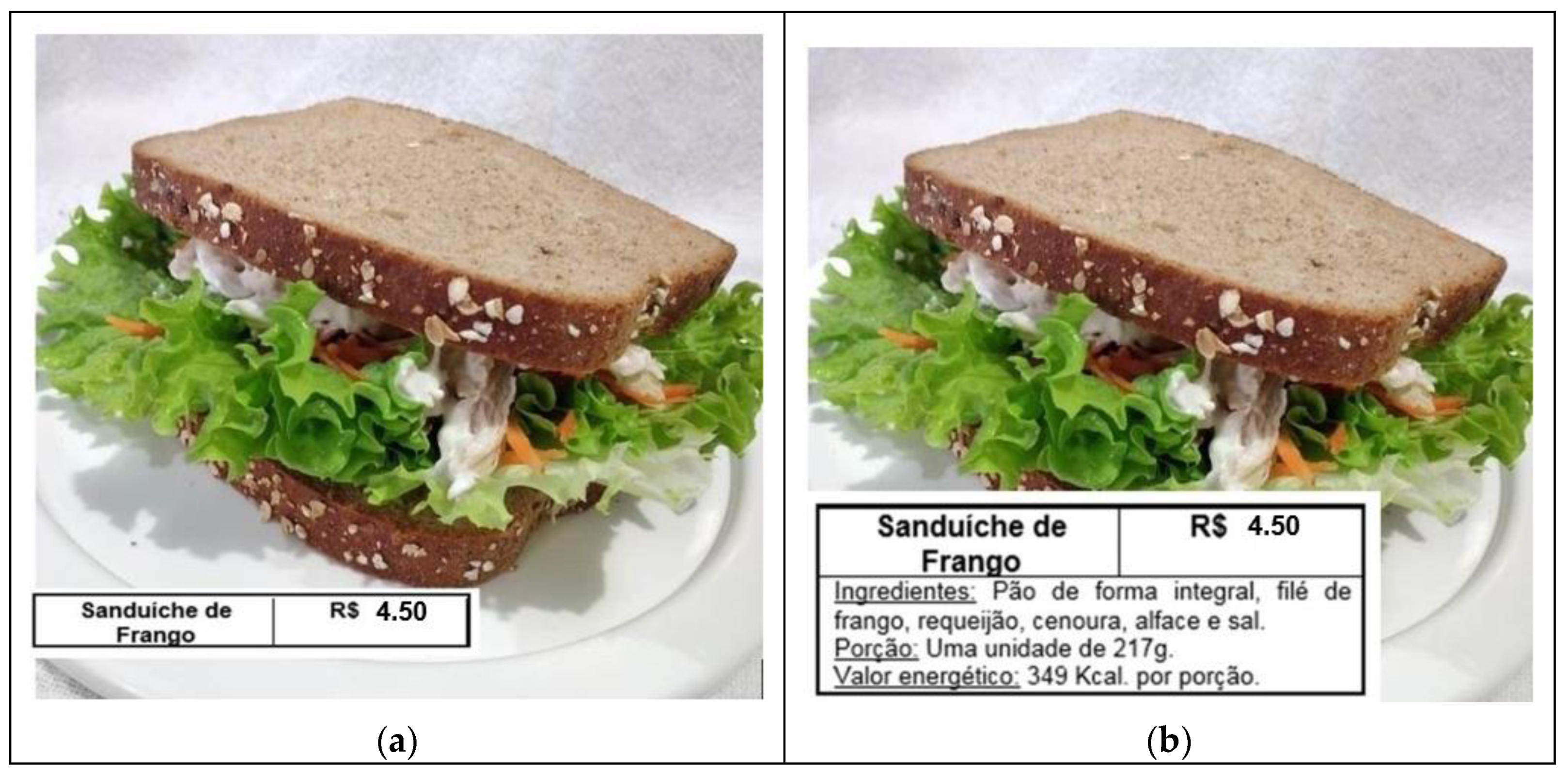
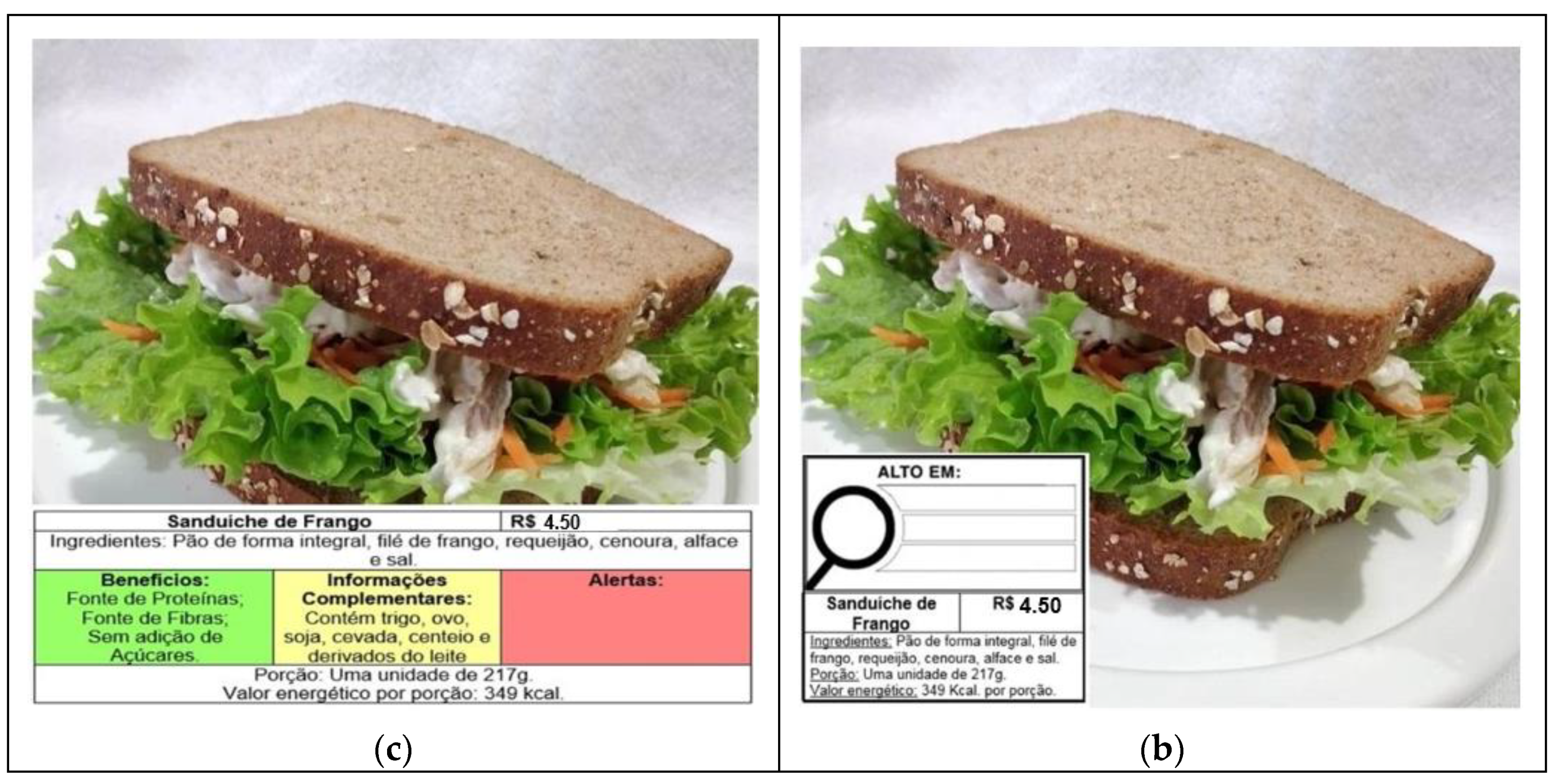
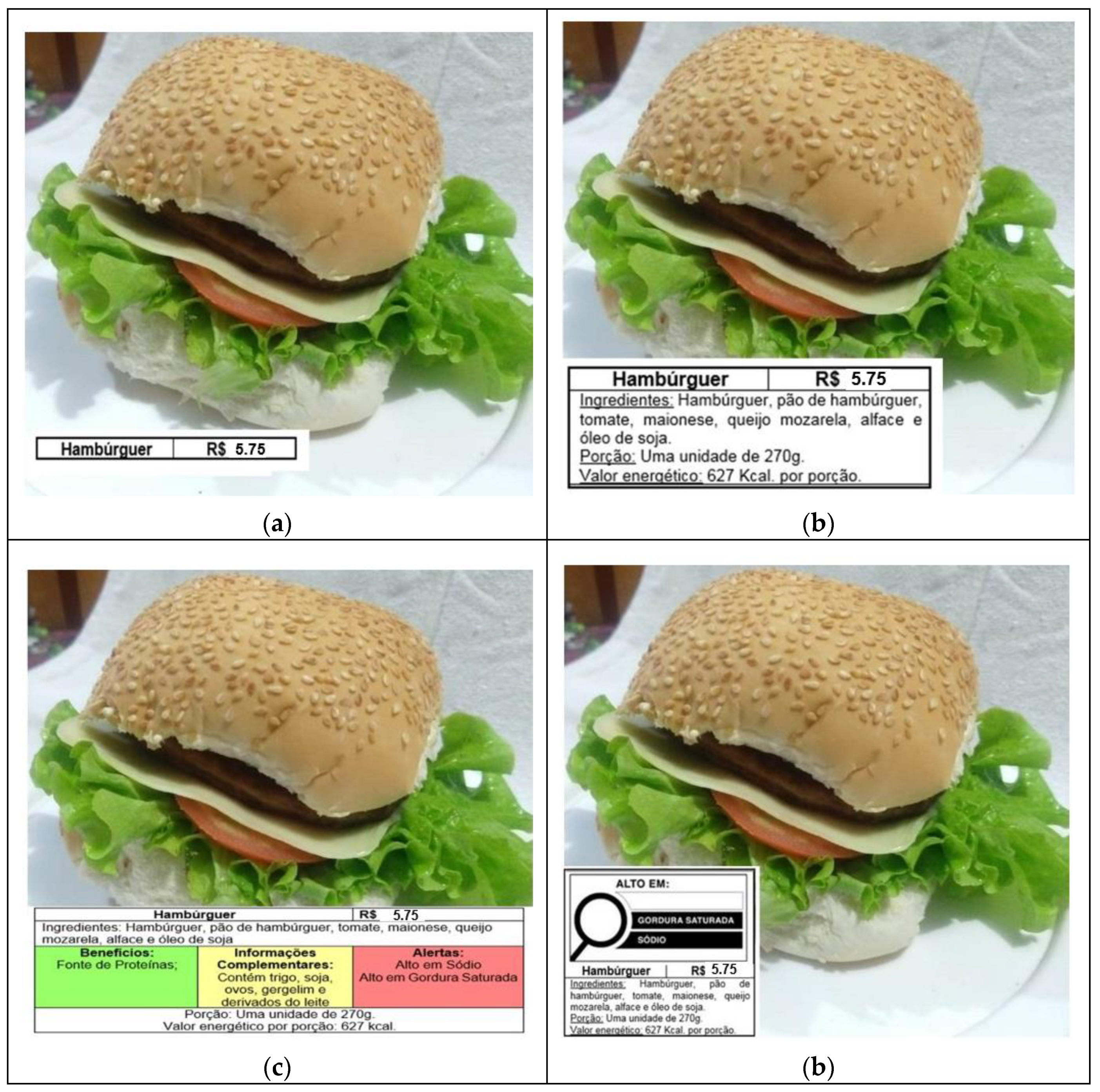
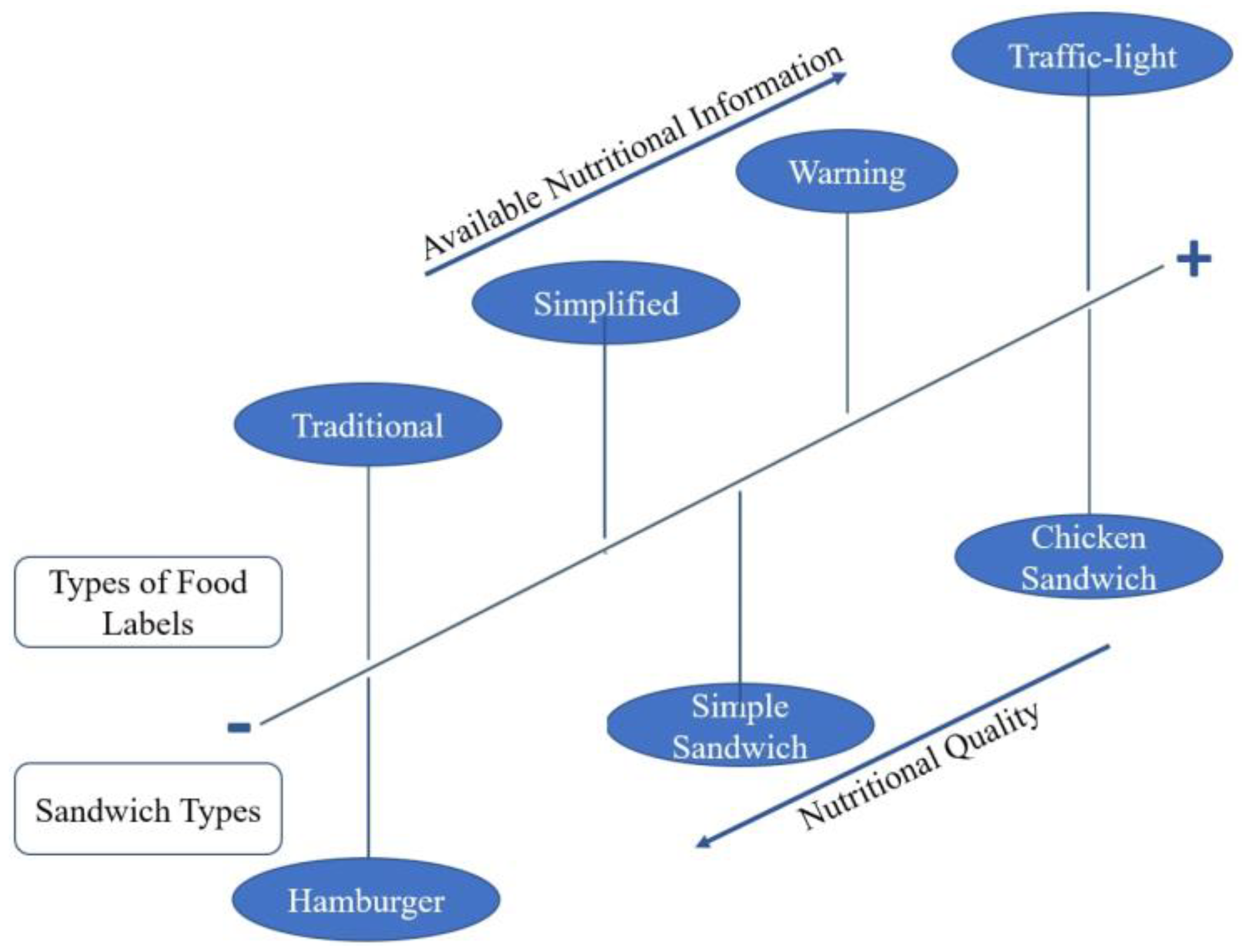
| Variables | n = 413 | % |
|---|---|---|
| Gender | ||
| Female | 355 | 86.0 |
| Male | 58 | 14.00 |
| Educational level | ||
| Complete High School | 45 | 11.0 |
| Incomplete University Education | 122 | 29.5 |
| Complete University Education | 115 | 27.8 |
| Master’s and/or PhD | 131 | 31.7 |
| Dietary Restrictions and Care | n | % |
|---|---|---|
| Lactose intolerance | 33 | 40.7 |
| Healthy eating | 21 | 25.9 |
| Vegetarianism | 12 | 14.8 |
| Diabetes Mellitus | 9 | 11.1 |
| Obesity/Overweight | 8 | 9.8 |
| Irritable bowel syndrome | 8 | 9.8 |
| Systemic Arterial Hypertension (SAH) | 7 | 8.6 |
| Celiac disease | 5 | 6.2 |
| Food allergy | 2 | 2.5 |
| Traditional n (%) | Simplified n (%) | Warning n (%) | Traffic-Light n (%) | |
|---|---|---|---|---|
| Influence of the food labeling models on the choice of sandwich by consumers | ||||
| Simple Sandwich | 31 (7.5) | 31 (7.5) | 19 (4.6) | 22 (5.3) |
| Chicken Sadwich | 3030 (73.4) | 331 (80.2) | 362 (87.7) | 358 (86.7) |
| Hamburger | 79 (19.1) | 51 (12.3) | 32 (7.7) | 33 (8.0) |
| Reason for the choice * | ||||
| Nutritional quality | 127 (32.3) | 200 (50.0) | 285 (71.8) | 293 (72.7) |
| Taste preference | 143 (36.4) | 143 (35.8) | 82 (20.7) | 89 (22.1) |
| Appearance | 114 (29.0) | 47 (11.8) | 27 (6.8) | 21 (5.1) |
| Price | 9 (2.3) | 10 (2.5) | 3 (0.8) | 0 (0.0) |
| Food labeling model preference ** | ||||
| Like very much | - | 275 (66.6) | 250 (60.5) | 317 (76.8) |
| Like slighfly | - | 107 (25.9) | 136 (32.9) | 85 (20.6) |
| Neither like nor dislike | - | 27 (6.5) | 17 (4.1) | 8 (1.9) |
| Dislike slighfly | - | 3 (0.7) | 7 (1.7) | 2 (0.2) |
| Deslike very much | - | 1 (0.2) | 2 (0.5) | 0 (0.0) |
| Preference test *** | ||||
| 1374 a,b,c | 1089 a,d | 1002 c,e | 755 b,d,e | |
| Consumer understanding level * | ||||
| Great | 134 (32.4) | 291 (70.5) | 203 (49.2) | |
| Good | 154 (37.3) | 94 (22.8) | 160 (38.7) | |
| Regular | 89 (21.5) | 17 (4.1) | 29 (7.0) | |
| Bad | 31 (7.5) | 6 (1.5) | 12 (2.9) | |
| Poor | 5 (1.2) | 4 (1.0) | 8 (1.9) | |
| Question | Completely Agree | Agree | Indifferent | Disagree | Completely Disagree |
|---|---|---|---|---|---|
| 18 (4.5) | 36 (9.0) | 25 (6.5) | 247 (60.0) | 82 (20.0) |
| 261 (63.2) | 136 (32.9) | 10 (2.4) | 1 (0.2) | 0 (0.0) |
| 256 (62.0) | 133 (32.5) | 16 (4.0) | 2 (0.5) | 1 (0.2) |
Publisher’s Note: MDPI stays neutral with regard to jurisdictional claims in published maps and institutional affiliations. |
© 2022 by the authors. Licensee MDPI, Basel, Switzerland. This article is an open access article distributed under the terms and conditions of the Creative Commons Attribution (CC BY) license (https://creativecommons.org/licenses/by/4.0/).
Share and Cite
Felipetto, N.; Scheffer, P.A.; Margutti, K.M.d.M.; Silveira, J.T.; Marques, C.T.; Storck, C.R.; Oliveira, V.R.d.; Helbig, E.; Ginani, V.C.; Saccol, A.L.d.F. Brazilian Consumers’ Perception towards Food Labeling Models Accompanying Self-Service Foods. Foods 2022, 11, 838. https://doi.org/10.3390/foods11060838
Felipetto N, Scheffer PA, Margutti KMdM, Silveira JT, Marques CT, Storck CR, Oliveira VRd, Helbig E, Ginani VC, Saccol ALdF. Brazilian Consumers’ Perception towards Food Labeling Models Accompanying Self-Service Foods. Foods. 2022; 11(6):838. https://doi.org/10.3390/foods11060838
Chicago/Turabian StyleFelipetto, Nariéli, Patrícia Arruda Scheffer, Karen Mello de Mattos Margutti, Joice Trindade Silveira, Clandio Timm Marques, Cátia Regina Storck, Viviani Ruffo de Oliveira, Elizabete Helbig, Verônica Cortez Ginani, and Ana Lúcia de Freitas Saccol. 2022. "Brazilian Consumers’ Perception towards Food Labeling Models Accompanying Self-Service Foods" Foods 11, no. 6: 838. https://doi.org/10.3390/foods11060838
APA StyleFelipetto, N., Scheffer, P. A., Margutti, K. M. d. M., Silveira, J. T., Marques, C. T., Storck, C. R., Oliveira, V. R. d., Helbig, E., Ginani, V. C., & Saccol, A. L. d. F. (2022). Brazilian Consumers’ Perception towards Food Labeling Models Accompanying Self-Service Foods. Foods, 11(6), 838. https://doi.org/10.3390/foods11060838








